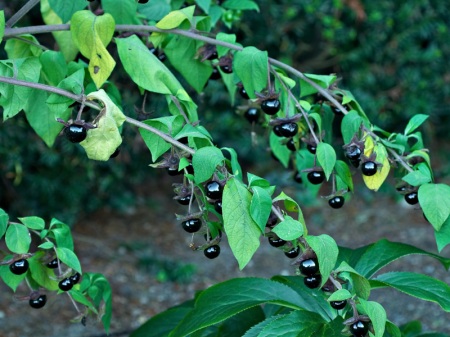
Mosquin, D. (2005). Solanaceae | Atropa belladonna L. | 34604-0433-1999. Retrieved from: http://www.botanicalgarden.ubc.ca/potd/2005/10/atropa_belladonna.php
Botanical Name: Atropa belladonna
Common name: Deadly Nightshade, Belladonna
Family: Solonaceae (Hoffmann, 2003, p. 122)
Parts used: Whole Plant (Grieve, 1971, p. 582)
Poisionous properties are associated with the green part of the plant, however the berries have shown to be toxic to children (Grieve, 1971, p. 583)
History/Folklore: The herb is traditionally used as a poison (Natural Standard, 2014).
The juice of the berry causes pupils to dilate, and was used traditionally to afford a striking appearance in women (Hoffmann, 2003, p. 123)
“As an antidote to Opium, Atropine may be injected subcutaneously, and it has also been used in poisoning… It has no action on the voluntary muscles, but the nerve endings in involuntary muscles are paralysed by large doses, the paralysis finally affecting the central nervous system, causing excitement and delirium.” (Grieve, n.d.)
Constituents: Tropane Alkaloids: incl. hyoscine (also known as scopolamine) and hyoscyamine (Natural Standard, 2014).
Atropine has a reported half-life of several hours and is rarely detectable in the plasma after 24 hours (Natural Standard, 2014).
Actions
- Narcotic (Grieve, 1971, p. 583)
- Powerful Respiratory Spasmolytic (Bone & Mills, 2013, p. 241)
- Anticholinergic (Natural Standard, 2014)
Indications
- Airway obstruction (Natural Standard, 2014)
- Autonomic nervous system disturbance (Natural Standard, 2014)
- Headache (Natural Standard, 2014)
- Irritable Bowel Syndrome (Natural Standard, 2014)
- Menopause (Natural Standard, 2014)
- Eye disease (Grieve, n.d.)
- Antidote to opium (Grieve, n.d.)
Has been investigated for the treatment of asthma and Parkinson’s (Natural Standard, 2014)
Dosage & Preparation:
- Used homeopathically (Natural Standard, 2014)
- Doses up to 1.5mg/day are traditionally considered safe (Natural Standard, 2014)
- Bruised, fresh leaves are used to ease pain and inflammation when applied topically (Grieve, 1971, p. 583)
Cautions & Contraindications
- Symptoms of belladonna overdose include confusion, agitation, hallucination, tachycardia, dry mouth, dilated pupils and other anticholinergic effects. Consumption of the herb can result in death (Natural Standard, 2014)
- Elderly patients (Natural Standard, 2014)
- Children (Natural Standard, 2014)
- Individuals with cardiac disease, due to cardiac effects (hypertension, tachycardia, arrhythmias) (Natural Standard, 2014)
- Gastrointestinal tract disease such as ulcers, esophageal reflux, hiatal hernia, obstructive gastrointestinal disease, constipation, ileus or atony, colitis, ileostomy or colostomy, as anticholinergic effects may delay gastric emptying and decrease esophageal pressure (Natural Standard, 2014)
- Neuromuscular disorders, as belladonna may cause neuromuscular blockade resulting in weakness or paralysis (Natural Standard, 2014)
- Fever (Natural Standard, 2014)
Interactions
- Anticholinergic agents (antihistamines, phenothiazines, and tricyclic antidepressants) as belladonna may increase the anticholinergic effects (Natural Standard, 2014)